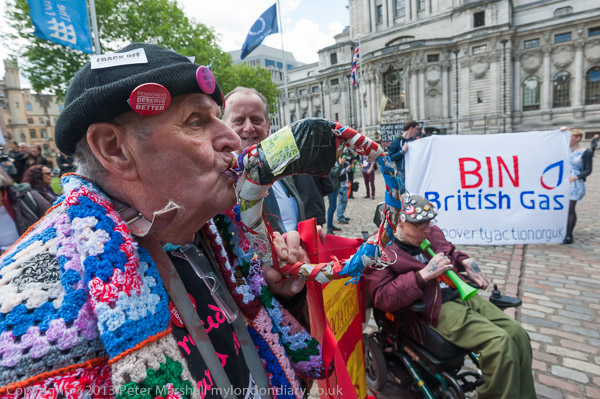
Back before the Thatcher era the idea of private companies making profits out of supplying gas seemed ridiculous. It was an industry with a single network of pipes across the country. Of course in the distant past we had over a thousand gas companies, each with its own area, some private and some municipal, all merged into the nationalised area ‘gas boards’ under Clement Atlee in the Gas Act 1948, and into the single British Gas in 1972.
It was an industry where nationalisation made sense, and I think delivered a better deal than the privatised British Gas created by the Thatcher government in 1986. For the next 10 years, domestic users had no choice of supplier, and it was only in 1998 that the market was fully open to competition.
It’s hard to see any real benefit for the consumer that privatisation has brought, and after recent price hikes few still believe there was any financial advantage – except to the shareholders of the privatised British Gas and other big energy companies and those who bought shares cheap and sold quickly at a large gain.
In the days of the gas boards things were simple. Anything to do with gas and you knew where to go. There was a ‘gas showroom’ in every town of any size where you could go and look at new gas appliances, and to pay your bill, and if you smelt a leak or needed maintenance or anything else, the board (and from 1972-86 British Gas) was the place to go. Things were simple and they worked pretty well. Much the same was true of electricity, again nationalised by the Atlee government – by the 1947 Electricity Act, and privatised in 1990.
Most people would prefer a simple national system for energy in the UK again, with a YouGov poll in November 2013 showing over two thirds of people backing the energy companies being brought back into the public sector and only 21% saying they should be private. Even among Conservative party voters over half – 52% – thought they should be re-nationalised. It is a pretty clear indictment of the current system, so it is perhaps surprising that none of the major political parties seems to be even considering renationalisation. I think it says something about how our democracy works -or rather fails, protecting some private interests rather than the public good.
Few of us can be bothered to change our energy suppliers to get a better deal – and many who have done so have found themselves actually paying more with an incredible level of misleading selling. In the 18 years it has been possible to switch suppliers I’ve only done so twice; once to get the small benefit of a ‘dual fuel discount’ from buying gas and electricity from the same supplier, and more recently for ecological reasons to a green energy company, Ecotricity, which has no shareholders but uses all its profits to develop new renewable energy services. As a bonus, it also seems to be saving me a little money.
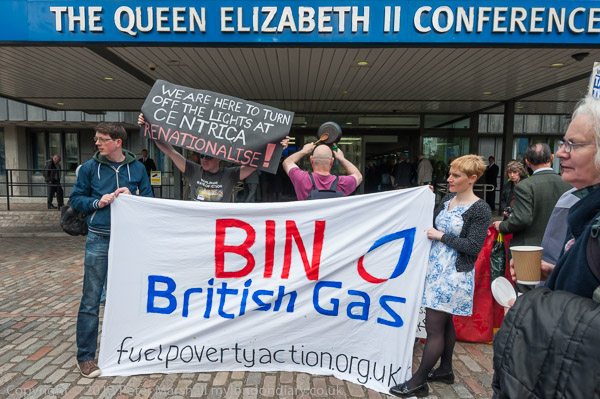
So I was very much in sympathy with the protesters outside the AGM of Centrica, the parent company of British Gas, a protest organised by Fuel Poverty Action, with their slogan ‘Bin British Gas’. You can read more about their aims and the protest, along with many more pictures in Bin British Gas on My London Diary.
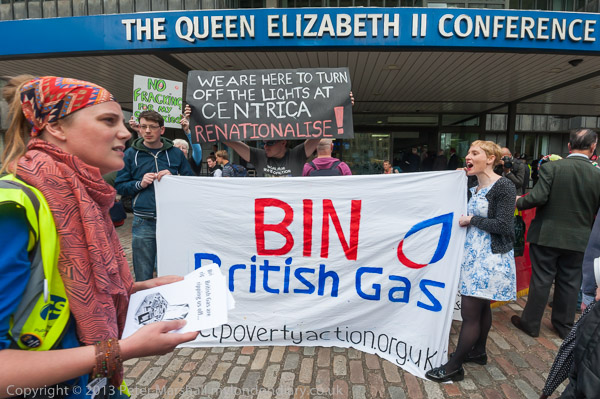
Another picture taken with the same lens, the Nikon 16-35mm f4 from more or less exactly the same position, but at a slightly wider focal length has a big difference. The name of the conference centre is straight on the upper image (at 22mm) but rather definitely curved in the lower 16mm version.
There is more distortion at the wider focal length, but the real reason for the difference in these pictures is that I have used the lens profile in Lightroom to correct the 22mm version. I could have done so for the lower image but chose not to. I have changed my default setting for the profile in Lightroom to use 0% distortion correction, because for most subjects the distortion actually gives a slightly less distorted looking effect at the edges of the pictures, avoiding a little of the problems of rectilinear correction on extreme wide angles. It also gives a slightly wider field of view, with any correction of distortion always resulting in a little loss at the edges.
The distortion is only generally a problem with architectural subjects and other things with obvious straight lines – as in this case. But correcting it would have lost more than I was willing to lose of the hair of the woman at the left of the image.
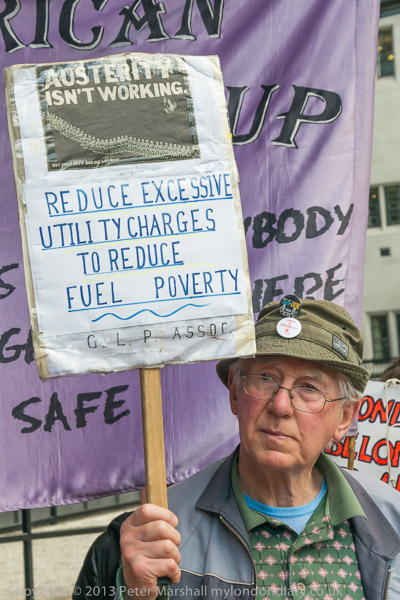
Pensioners are among those hardest hit by high fuel prices – many now find themselves having to chose between keeping warm or eating. I took several pictures of one of them holding a hand-made placard. I think this was the best, though probably it would be improved by a little crop at top and right, but you can see another version on My London Diary. Obviously the face and placard were both important, but less obviously I think his hand gripping the placard adds to the picture. As (almost) always the images are un-posed.
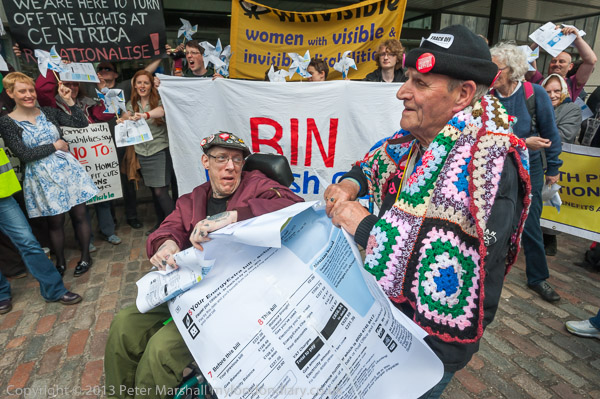
I rather like the picture of a giant gas bill being torn up, though it proved a little difficult for them to tear. I was surrounded by other photographers when taking this and the other pictures and unable to move much, but I’d chosen a fairly good position – thinking in advance what was likely to happen and where and getting there before the others.
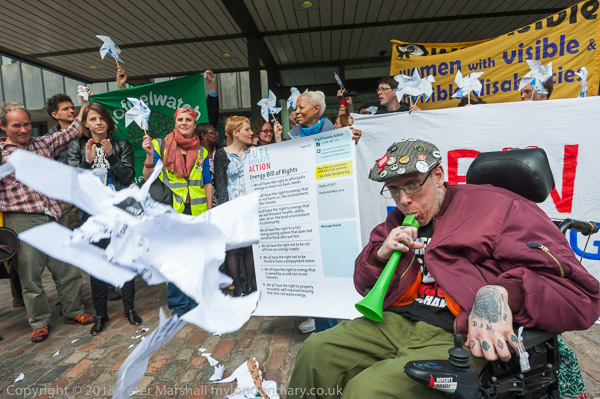
They did eventually tear it to pieces and then Terry who was right next to me threw them into the air. It was a picture with no second chances and I would have liked more of the pieces to have been the other way round – ideally to show the British Gas logo. But you have to take what you can.
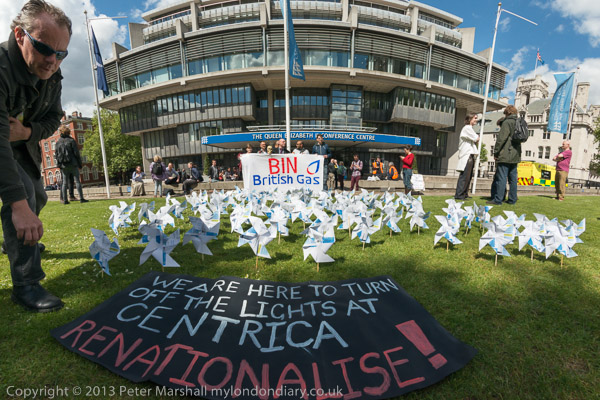
The finale of the protest was the planting of windmills made from folded gas bills in the grass in front of the centre. They had been planning to do so on Parliament Square in front of the House of Commons which might have made a better picture, though the ‘Heritage Wardens’ there would certainly have objected. There were supposed to have been 100 of them, but quite a few didn’t get planted
Along with the other photographers present (and we did get in each other’s way a little) I had a few minutes to think about how to take this, and to try different ideas, with focal lengths from 16mm fisheye to 70-300mm telephoto. There are four different views at Bin British Gas but this is my favourite.
______________________________________________________
My London Diary : Buildings of London : River Lea/Lee Valley : London’s Industrial Heritage
All photographs on this and my other sites, unless otherwise stated, are taken by and copyright of Peter Marshall, and are available for reproduction or can be bought as prints.
To order prints or reproduce images
________________________________________________________